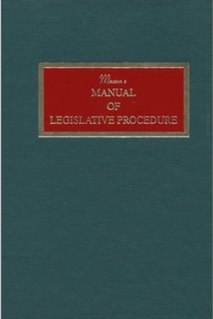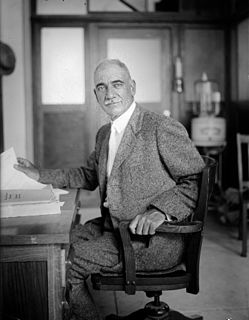
Robert's Rules of Order Newly Revised, commonly referred to as Robert’s Rules of Order, RONR, or simply Robert’s Rules, is the most widely used manual of parliamentary procedure in the United States. It governs the meetings of a diverse range of organizations—including church groups, county commissions, homeowners associations, nonprofit associations, professional societies, school boards, and trade unions—that have adopted it as their parliamentary authority.

Parliamentary procedure is the body of rules, ethics and customs governing meetings and other operations of clubs, organizations, legislative bodies and other deliberative assemblies.

A Legislative Consent Motion is a motion passed by either the Scottish Parliament, Welsh Assembly, or Northern Ireland Assembly, in which it agrees that the Parliament of the United Kingdom may pass legislation on a devolved issue over which the devolved body has regular legislative authority.
In deliberative bodies a second to a proposed motion is an indication that there is at least one person besides the mover that is interested in seeing the motion come before the meeting. It does not necessarily indicate that the seconder favors the motion.
A repeal is the removal or reversal of a law. There are two basic types of repeal, a repeal with a re-enactment of the repealed law, or a repeal without any replacement.
In parliamentary procedure, the previous question is generally used as a motion to end debate on a pending proposal and bring it to an immediate vote. The meaning of this specialized motion has nothing to do with any question previously considered by the assembly.

Mason's Manual of Legislative Procedure, commonly referred to as Mason's Manual, is the official parliamentary authority of most state legislatures in the United States. This 700+ page book has been "Adopted as the authority on questions of parliamentary law and procedure in California, it is to legislatures what Robert's Rules of Order is to club groups. Gleaned from court decisions and legislative precedents, salted by practical experience, it is... [used] by legislatures throughout the U.S. and its territories. Adopted by the parliament of India and Pakistan."
In parliamentary procedure, reconsideration of a motion may be done on a matter previously decided. The motion to "reconsider" is used for this purpose. This motion originated in the United States and is generally not used in parliaments. A special form of this motion is reconsider and enter on the minutes.
In parliamentary procedure, an objection to the consideration of a question is a motion that is adopted to prevent an original main motion from coming before the assembly. This motion is different from an objection to a unanimous consent request.
In parliamentary procedure, a motion to appeal from the decision of the chair is used to challenge a ruling of the chair.
In parliamentary procedure as defined in Robert's Rules of Order, a motion is a formal proposal by a member of a deliberative assembly that the assembly take certain action.
A parliamentarian is an expert on parliamentary procedure who advises organizations and deliberative assemblies. This sense of the term "parliamentarian" is distinct from the usage of the same term to mean a member of Parliament.
In parliamentary procedure, a suspension of the rules allows a deliberative assembly to set aside its normal rules to do something that it could not do otherwise. However, there are rules that cannot be suspended.
Debate in parliamentary procedure refers to discussion on the merits of a pending question; that is, whether it should or should not be agreed to. It is also commonly referred to as "discussion".
In parliamentary procedure, requests and inquiries are motions used by members of a deliberative assembly to obtain information or to do or have something done that requires permission of the assembly. Except for a request to be excused from a duty, these requests and inquiries are not debatable nor amendable.
The history of parliamentary procedure refers to the origins and evolution of parliamentary law used by deliberative assemblies.
In parliamentary procedure, the verb to table has the opposite meaning in different countries:





